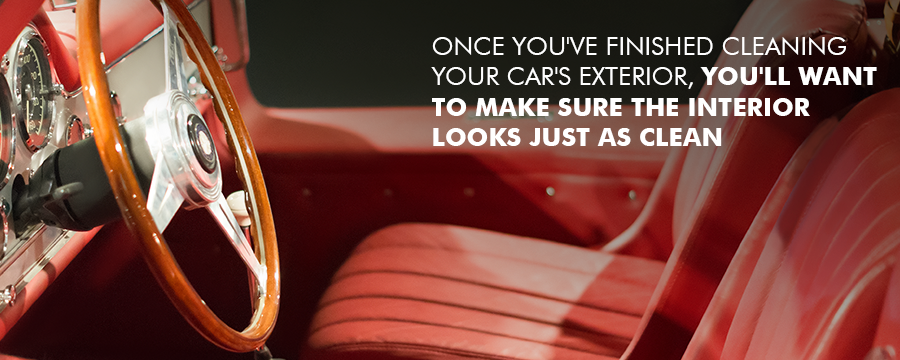
How to Clean A Classic Car - Collector Car Detailing
If you own a classic car, you've likely already made several substantial investments in it and thus want to keep it in pristine condition. Here at Volo, we take pride in maintaining our cars to keep them looking and running like they did on day one.
While you probably already know that you shouldn't take your vehicle to a regular drive-through car wash, you may not be aware of the many other tips for washing your classic car. Knowing these rules is crucial to any classic car owner. Proper cleaning will keep the car looking its best while also preventing damage and retaining its value.
Table of Contents
- Preparing to Clean Your Classic Car
- Cleaning the Outside of Your Classic Car
- Cleaning the Inside of a Classic Car
- Looking for Your Classic Dream Car?

Why Is Cleaning a Classic Car Different?
Unlike a regular car, classic cars need to be washed with precision using specialized materials. Using the wrong tools or products while cleaning your vehicle may result in damage that will be difficult and costly to repair. Since classic cars are more likely to develop rust issues, you will also have to make sure you are taking extra steps when drying to avoid rust damage.
If you drive your car regularly, you will want to wash it about once a week — just a bit more often than the recommended two weeks for a regular car. Cleaning your classic automobile is far more important than cleaning a regular vehicle, as it carries a significant amount of value that can be lost if contaminants like bugs or dirt are allowed to build up on the outside.
Whether you're entering a car show or just want to drive your vehicle around town, the following are a few things you should know to keep your car looking its best.
Preparing to Clean Your Classic Car

Ready to get started? Before you can begin, you'll need to gather all the materials necessary to give your vehicle a proper cleaning. Follow this step-by-step guide to prepare to wash your classic car:
- The first step to any safe and effective car washing is making sure you have the right cleaning materials. For starters, you should have sheepskin or cotton chenille washing mitts or towels to wash the vehicle's exterior. These tools provide more speed and convenience than a sponge or brush, and their soft, high-quality material will not leave any marks on the surface. At the end of your wash, you'll also need a soft leather chamois or a soft microfiber towel to dry off your vehicle, since a regular hand towel may scratch the surface.
- Next, you'll want to choose the right kind of soap. Avoid cleaning your car with dish soap or low-quality cleaner. Instead, use high-quality soaps like Turtle Wax that are specifically designed for washing your vehicle. Make sure the detergent you use contains no abrasives, as they will wear away your vehicle's paint.
- Finally, a clay bar kit can be handy if you want to protect your car's paint from airborne pollution and contaminants that regular handwashing and waxing will not remove on their own.
Specialty items like the equipment mentioned above should fully prepare you for cleaning your car's exterior.
The supplies you'll need to clean the inside of your vehicle will change based on the material of the car's seats and other interior items. For example, a leather interior will need an upholstery attachment for a vacuum, while a fabric interior will only need a standard vacuum attachment. You'll also need other interior cleaners, which we'll later discuss more in-depth.
Cleaning the Outside of Your Classic Car
Now that you have everything you need to clean and detail your car's exterior, you can start cleaning it safely in the most effective way possible. Below are some tips to help you keep your classic car looking like it just came off the lot:
- Handwash only: Don't take your classic car anywhere near a machine. You won't likely get an effective cleaning. Further, you may be putting your vehicle at risk for damage. Instead, wash it by hand using your sheepskin or cotton chenille washing mitts to keep your car in mint condition. If you can't easily reach certain areas by hand, you can use a toothbrush with soft bristles.
- Stay in the shade: Unlike their drivers, cars do not like to sunbathe — especially when they're being cleaned. The sun could make the soap evaporate quickly, leaving streaks and spots on the paint. Instead, try to wash your car in the shade.
- Wash from the top down: This relates directly to one of the fundamental laws of our world: gravity. If you start at the bottom of your car and work your way up, grime and other contaminants will drop onto sections that are already clean. Also, if you are only using one mitt or towel, starting at the bottom could cause you to transfer the harsh metal shavings and oil from the brakes onto the rest of the car.
- Use the right soap: While ordinary dish soap might get your car clean, it will also dull your paint job and give it a "used" quality. Not only will it make your car less eye-catching, but it will also lessen its value. Instead of spending the money and time to repaint your car after bathing it, you should use specially designed, abrasive-free carwash soap to keep your car looking as pristine as ever.
- Clean your wheels last: After you've washed the painted section of your car, it's time to focus on your vehicle's grimiest area — the wheels. Since they will have more buildup than anywhere else, you should use a new towel or mitt for the most effective cleansing.
- Rinse it: Once your car has been thoroughly cleaned, use a steady stream of water to rinse it off. Try to avoid using more water than you have to. Excessive water use could create pooling in hard-to-reach areas, which may cause rust damage.
- Dry it thoroughly: Even though water might seem harmless enough, it contains small minerals that will leave marks on your car. To prevent these marks from ruining your paint job, use specialty towels to dry the vehicle from the top down. Ensure you are drying even the hardest-to-reach areas to avoid rust. Since your wheels and tires will be greasy even after washing, don't dry them off until the end — you don't want to risk spreading even a small amount of grease to the rest of the car.
- Use a clay bar: If you notice your car's paint feels rough or gritty after you've washed and dried it, you can use a clay bar to smooth it out and get rid of any hard-to-remove contaminants like road salt. Just remember to spray detailing lubricant on the paint before rubbing it with the clay bar.
- Wax regularly: Though you will not need to wax your car every time you wash it, you should plan to wax it every six to eight weeks if you drive it regularly. Waxing will protect your vehicle's paint from environmental elements and UV damage while keeping it just as shiny as the day it was sold. Like the wash itself, you will want to wax your car in the shade since the wax can haze hot paint.
- Polish your chrome: If your vehicle has chrome on it, you will want to proactively make sure it stays in top shape. Look for a high-quality chrome polish to use every time you wash your car.
- Use tire conditioner: To protect your tires from early tire degradation and aging, apply a tire conditioner after cleaning them after they have dried completely. This extra step will protect your tires while also giving them a fresh, jet-black look.

Cleaning the Inside of a Classic Car
Now that you know how to clean the exterior of your classic car, you'll want to make sure the interior looks just as clean. Removing stains and picking up any debris on the floors and seats are critical first steps to keep it looking tidy. However, you should also use many other procedures and materials while you clean your classic car. By following these tips for each surface type, you can keep your vehicle's interior clean and tidy while also maintaining its original look.
- Windows and glass: Though Windex might be great for your windows at home, it will not work well for your car's glass. You will need to be using a more specialized automotive glass cleaner that will leave the windows with a streak-free finish.
- Dusting: Even though it's right in front of you, the dust coating your dashboard is easy to forget about. The best way to dust off of your classic car is with a microfiber towel that attracts dust to it.
- Carpet: To begin, you should thoroughly brush and vacuum the carpet. Next, you will want to clean about one square foot of your carpet at a time with a foaming-type upholstery cleaner. Then, vacuum again to catch any excess residue from the cleaner. To go the extra mile, you can even fluff the carpet pile with compressed air. To finish, dry the carpet before you use your car.
- Vinyl and leather surfaces: You can easily clean combination leather and vinyl seats using a vacuum with an upholstery attachment, which prevents damage to the leather. After they have been vacuumed, spray them lightly with a leather seat cleaner and conditioner, and wipe off with a soft cloth. Vinyl or plastic surfaces can be cleaned with warm water and mild soaps. Finally, use a dry cloth to remove any remaining moisture.
- Fabric surfaces: Like vinyl and leather surfaces, you'll start to clean fabric seats by vacuuming the car. You can use a regular vacuum attachment. Next, use a cleaner to remove stains and keep the fabric clean. While three categories of acceptable detergents — volatile, synthetic and non-alkaline — are available, volatile cleaners are ideal for your classic car needs. Synthetic detergents break up stains well, but they can hurt the fabric's appearance. Neutral soaps are also less effective. Volatile cleaners, on the other hand, have a high solvency and protect the fabric's coloration. Make sure to use one designed specifically for cleaning cars. After applying the cleaner and scrubbing out stains, let the area dry and then vacuum it again.
- Convertible and vinyl tops: You should clean convertibles with lukewarm water, neutral soap suds and a brush with soft bristles. After scrubbing your vehicle, you can use a mild foaming cleanser — while making sure it doesn't run onto the body finish — if it needs more cleaning. Finally, rinse the top with water and dry it thoroughly. Lowering the top into the car body while it's still wet could cause mildew or unattractive wrinkling.
- Polyurethane foam material: To removing soiling on any polyurethane trim in your car, you can use a combination of detergent powder and water. If the polyurethane has been dirtied by sealers or grease, apply the cleaning solution onto the affected spot, leaving the suds on the area to break up the dirt. You can then clean it with a cloth that has been dipped into volatile upholstery cleaner and wrung out. Next, reapply the suds and finish by rinsing them out with a sponge and clean water.

Now that you know how to clean a classic car, it is now time to start!
View Other Guides on Muscle Cars:
- How Often to Change Car's Oils and Fluids
- Classic Car Maintenance Tips
- How to Find an Oil Leak in a Classic Car? | Troubleshooting
Looking for Your Classic Dream Car?
If you're in the market for your dream classic car, we want to help. At Volo Auto Sales, we have an extensive collection of classic cars, and we would love to talk with you as soon as possible. Give us a call or send us a message today!



